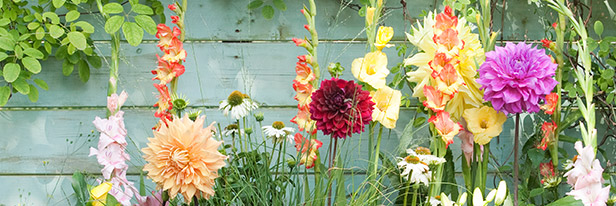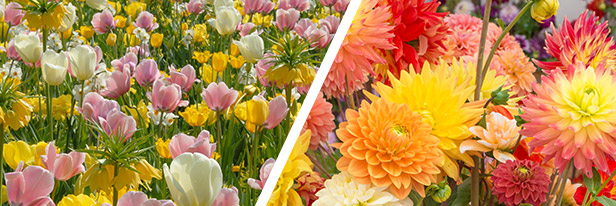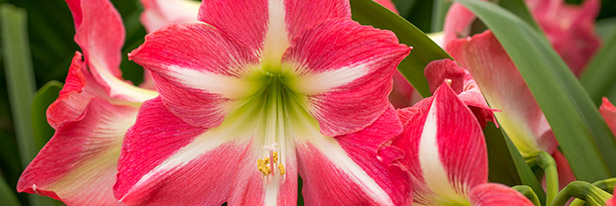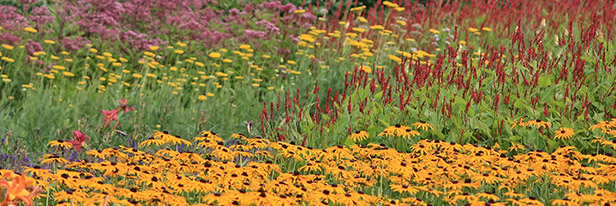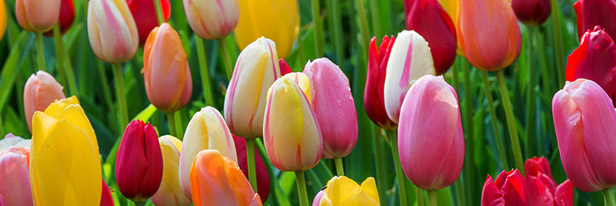
Planting Flower Bulbs
September 25, 2019
QFB
Whether your garden is small or large, there is always a place to plant bulbs . For example in a border with perennials. Borders usually only bloom from mid-May. With early spring bulbs, such a border will be lovely to look at much earlier. For example, give crocuses and spring anemones ( Anemone blanda) a place between low perennials on the edge. Amid higher perennials there is often room for tulips, Camassias and stately ornamental onions. There are also suitable bulbs for areas with a bit more shade. Scilla , Chionodoxa, Erythronium and certain types of daffodils provide a colourful accent between deciduous and evergreen shrubs.
When is the best time to plant your bulbs?
Spring flowering bulbs
This includes Daffodils, Hyacinths, Tulips, Crocuses and Alliums. In general, these bulbs are best planted when the soil temperature is below 9 degrees. Depending on the outside temperature, the bulbs can therefore be planted from September to December (with an extension to January if frost is not present).
Summer bloomers
Varieties such as Begonias and Dahlias are true summer bloomers. These bulbs and tubers are best planted from May (after Ice Saints in mid-May). We do recommend planting your summer bloomers before the longest day (June 21).
It is also possible to enjoy your summer bloomers earlier. For example, from the end of February you can already plant many summer bloomers, such as tuberous begonias, indoors. We call this ‘pulling’. Place the planted summer bloomers in a bright place and at a temperature of up to approximately 18 degrees Celsius. From mid-May, the pots can go outside, or the plants can be placed in open ground.
Planting
First loosen the soil well with a spade where the flower bulbs will be. Then the earth is easily to work with.
For the planting distance, keep 3x the width of the bulb, and for the depth of planting also keep 2x the height of the bulb. Thus, 2 inch tulips should be planted 4 inch deep and 6 inch apart. You can look up the detailed planting information per product on each package or on the product page in our webshop.
Dig a hole with a spade or a bulb planter. Plant the flower bulbs in the hole with the tip up and the root roots down. Close the hole with the excavated earth and press it down a bit.
Water the bulbs immediately after planting. In this way they are encouraged to start making roots. The earlier the roots are formed, the greater the chance that everything will bloom and the faster the spring flowering bulbs will withstand cold and frost.
Soil type and drainage
In sandy soil, the rainwater is drained quite easily. Clay soil, on the other hand, tends to remain moist for a long time. Bulbs do not like wet feet, so if they are in clay soil, make sure the water can drain. You can make clay soil a bit more airy by mixing in sand or compost. You can also sprinkle some fine pebbles or cat litter in the planting holes before the bulbs go in.
Clients from the US or Canada might have different questions and demands. Read our planting instructions especially for the US and Canada here.
Flower bulbs in pots and containers
The terrace and balcony are increasingly seen as an extension of the living room. In the summer, you will have bright summer bloomers and one year perennials in pots and containers. In the spring, spring bloomers can bring colour and a lively atmosphere.
Planting flower bulbs in pots is easy. Choose a pot that is not too small or has a drainage hole at the bottom. Place some potsherds and some clay granules over this hole. This allows the excess water to drain easily. Then you fill the pot or container. Use so much potting soil that the bulbs can be planted at the correct planting depth. Now place the bulbs and fill the pot further with soil to just below the rim.
Bulbs in pots and containers should be a little closer together than in the open ground. That gives a nicer effect. If you have several pots of bulbs, put them together in a sheltered spot in winter for extra protection. To prevent the bulbs from freezing in the pot, place them close to the house or shed in winter.
Lasagna planting
Both in open ground and in pots and containers you can plant flower bulbs in layers one above the other; lasagna planting . The bottom layer consists of bulbs that bloom last, for example tulips. Bulbs that bloom earlier such as crocus or iris reticulata are planted on top. Bulbs can easily be placed one above the other. So they bloom as usual, one after the other, but then in the same place. This way you can let a pot or container bloom for weeks. Would you like to do this yourself? Then follow our lasagna planting instructions!

